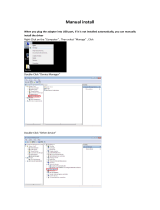
TL-WDN4800 450Mbps Wireless N Dual Band PCI Express Adapter
2
Chapter 1. Introduction
1.1 Overview of the product
The adapter is designed to provide a high-speed and unrivaled wireless performance for your
notebook and PC. With a faster wireless connection, you can get a better Internet experience,
such as downloading, gaming, video streaming and so on.
The TL-WDN4800’s auto-sensing capability allows high packet transfer rate of up to 450Mbps for
maximum throughput. It has good capability on anti-jamming; it can also interoperate with other
wireless (802.11a/b/g/n) products. The adapter supports WEP, WPA and WPA2 encryption to
prevent outside intrusion and protect your personal information from being exposed.
The Quick Setup Wizard guides you step-by-step through the installation process; the TP-LINK
Wireless Configuration Utility helps you create a wireless connection immediately.
With unmatched wireless performance, reception, and security protection, the TL-WDN4800 is
the best choice for easily adding or upgrading wireless connectivity.
1.2 Features
¾ IEEE802.11a, IEEE802.11b, IEEE802.11g, IEEE802.11n standards
¾ Supports WPA/WPA2 data security, IEEE802.1x authentication, TKIP/AES encryption, WEP
encryption
¾ Make use of IEEE 802.11n wireless technology to provide a wireless data rate of up to
450Mbps
¾ supports automatically adjust to lower speeds due to distance or other operating limitations
¾ Provides PCI Express interface
¾ Supports Ad-Hoc and Infrastructure modes
¾ Good capability on anti-jamming
¾ Supports roaming between access points when configured in Infrastructure mode
¾ Ease to configure and provides monitoring information
¾ Supports Windows XP, Windows Vista and Windows 7






















